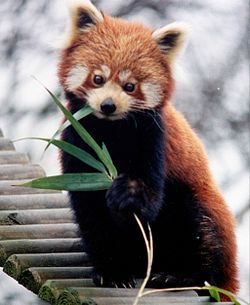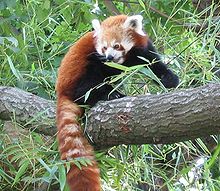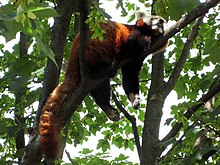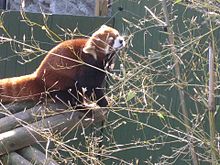Red panda
| Red Panda | |
|---|---|

| |
| Scientific classification | |
| Kingdom: | |
| Phylum: | |
| Class: | |
| Subclass: | |
| Superorder: | |
| Order: | |
| Suborder: | |
| Superfamily: | |
| Family: | |
| Genus: | Ailurus F. Cuvier, 1825
|
| Species: | A. fulgens
|
| Subspecies: | A. fulgens fulgens
A. fulgens refulgens (or A. fulgens styani) |
| Binomial name | |
| Ailurus fulgens F. Cuvier, 1825
| |

| |
| Red Panda range | |
| Synonyms | |
|
A. ochraceus Hodgson, 1847 | |
The Red Panda, also called the Firefox or Lesser Panda (taxonomic name: Ailurus fulgens, "shining cat"), is a small arboreal mammal and the only species of the genus Ailurus. It has been previously classified in the families Procyonidae (raccoon) And Ursidae (bears), but recent research has placed it in its own family Ailuridae.[2] Two subspecies are recognised.
Endemic to the temperate forests of the Himalayas, the Red Panda ranges from Nepal in the west to China in the east. It is also found in northern India, Bhutan and northern Myanmar.[3] Slightly larger than a domestic cat, it has reddish-brown fur, a long, shaggy tail, and a waddling gait due to its shorter front legs. The Red Panda eats mainly bamboo, but is omnivorous and may also consume eggs, birds, insects, and small mammals. It is a solitary animal, mainly active at dusk and dawn, and is largely sedentary during the day.
Classified as Vulnerable on the IUCN red list (2009.01), the Red Panda is listed in CITES appendix I. Accurate population figures are difficult to find, with estimates of wild populations ranging from 11,000 to 20,000 worldwide. Although it is protected by law in all countries where it lives, its numbers continue to decline mainly due to habitat loss and fragmentation, poaching, and inbreeding depression.[1]
The Red Panda is quite adaptable to living in captivity, and is common in zoos worldwide. As of 2006 the international studbook shows more than 800 individuals in zoos and parks around the world.
Etymology

English soldier and naturalist Thomas Hardwicke introduced this animal as the "Red Panda" to Europeans in 1821. The Western word "Panda" has no conclusive source. The names nigalya ponya and nyala ponga are often mentioned, and are said to mean "eater of bamboo" in Nepali. However, none of these words appear in Nepali-English dictionaries.[4][5] The Red Panda is also known as the Wah because of its distinctive cry, and has been called a Cat Bear because it was thought to be related to a small bear and washes itself like a cat by licking its entire body. Other names include Lesser Panda, Bear Cat, Bright Panda, Common Panda, Fire Fox, Red Fox, Fox Bear, Himalayan Raccoon, Cokoloaca Pigara, Gambawarella, Nigalya Ponya, Panda Chico, Panda Éclatant, Petit Panda, Poonya, Crimson Ngo, Red Cat, Sankam, Small Panda, Thokya, Wokdonka, Woker and Ye.[6]
Phylogenetics
The taxonomic classification of the Red Panda has been controversial since it was discovered. French zoologist Frédéric Cuvier initially described the Red Panda in 1825, and classified it as a close relative of the Raccoon (Procyonidae), even though he gave it the genus name Ailurus "cat" based on superficial similarities with domestic cats. The specific epithet is the Latin adjective fulgens "shining".[7] At various times it has been placed in Procyonidae, Ursidae, with Ailuropoda in Ailuridae, and in its own family, Ailuridae. This uncertainty comes from difficulty determining whether certain characteristics of Ailurus are phylogenetically conservative or are derived and convergent with species of similar ecological habits.[8]
Evidence based on the fossil record, serology, karyology, behavior, anatomy, and reproduction reflect closer affinities with Procyonidae than Ursidae. However, ecological and foraging specializations and distinct geographical distribution in relation to modern Procyonids support classification in a separate family (Ailuridae).[8][9][10]
Recent molecular-systematic DNA research also places the Red Panda into its own family Ailuridae, which is in turn part of the broad superfamily Musteloidea that also includes the Mephitidae (skunks), Procyonidae (raccoons), and Mustelidae (weasels) families.[11][2][10]
It is not a bear, nor closely related to the giant panda, nor a raccoon, nor a lineage of uncertain affinities. Rather it is a basal lineage of musteloid, with a long history of independence from its closest relatives (skunks, raccoons, and otters/weasels/badgers).
— Flynn et al., Whence the Red Panda,[2] p197
Subspecies
There are two extant subspecies of Red Panda. The Western Red Panda (Ailurus fulgens fulgens F. G. Cuvier, 1825) lives in the western part of its range (Nepal, Assam, Sikkim and Bhutan), and the somewhat larger Styan's Red Panda (Ailurus fulgens refulgens Milne-Edwards, 1874 or Ailurus fulgens styani Thomas, 1902) lives in the east-northeastern part of its range (southern China and northern Myanmar).[9] As of 2009, there is still some confusion about the subspecies names. Some sources including the studbook [12][13] show the name of the Eastern subspecies as "styani" while other sources show it as "refulgens."[14][15][16] The Western subspecies has lighter pelage (coat), especially in the face, while the Styan's Red Panda has more pronounced facial markings.
Evolutionary history
The Red Panda is only distantly related to the Giant Panda (Ailuropoda melanoleuca); the common ancestor can be traced back to the Early Tertiary Period tens of millions of years ago, with a wide distribution across Eurasia. Fossils of the Red Panda have been unearthed from China in the east to Britain (Parailurus anglicus) in the west (Hu, 1990,Ro), and most recently a handful of fossils (Pristinailurus bristoli, Miocene,[17][18] considered to be a new genus and species of the Red Panda)[19] have also been discovered in North America.
Distribution and habitat

The Red Panda is found mainly in temperate forests in the Himalayas, especially in the foothills of western Nepal, southern Tibet, Sikkim, Assam and Bhutan, in the northern mountains of Myanmar, and in southern China in the provinces of Sichuan (Hengduan Mountains) and Yunnan (Gongshan Mountains). It may also live in southwest Tibet and northern Arunachal Pradesh, but this has not been documented.[8] The Red Panda has become extinct in the Chinese provinces of Guizhou, Gansu, Shaanxi and Qinghai.[20]
The effective population size of the Sichuan population is larger and more stable than that of the Yunnan population, implying a southward expansion from Sichuan to Yunnan.[21] Locations with the highest density of Red Pandas include an area in the Himalayas that has been proposed as having been a refuge for a variety of endemic species in the Pleistocene.[8]
Distribution of the Red Panda is disjointed. The Brahmaputra river, where it makes a curve around the eastern end of the Himalayas, is often considered the natural division between the two subspecies, although some authors suggest that A. f fulgens extends farther eastward, into China.
The Red Panda lives between 2,200 and 4,800 meters (7,200 and 15,700 ft) altitude, inhabiting areas of moderate temperature (between 10 and 25 °C (50 and 77 °F)*) with little annual change. It prefers mountainous mixed deciduous and conifer forests, especially with old trees and dense understories of bamboo.[22]
Biology and behaviour

Physical characteristics
The Red Panda is 79 to 120 cm (31 to 47 in) long, including the tail length of 30 to 60 cm (12 to 24 in). Males weigh 4.5 to 6.2 kg (10 to 14 lb); females 3 to 4.5 kg (7 to 10 lb). It has long, soft reddish-brown fur on its upper parts, blackish fur on its lower parts, and a light face with tear markings and robust cranial-dental features. The light face has white badges similar to those of a raccoon, but each individual can have distinctive markings. Its roundish head has medium-sized upright ears, a black nose, and very dark eyes: almost pitch black. Its long bushy tail with six alternating yellowish red transverse ochre rings provides balance and excellent camouflage against its habitat of moss- and lichen-covered trees. The legs are black, short with thick fur on the soles of the paws hiding scent glands and serving as thermal insulation on snow-covered or ice surfaces.
The Red Panda is specialized as a bamboo feeder with strong, curved and sharp semi-retractile claws standing inward for grasping of narrow tree branches, leaves and fruit. Like the Giant Panda, it has a “false thumb” that is an extension of the wrist bone.

Behaviour
The Red Pandas is crepuscular (most active at dawn and dusk), sleeping on tree branches or in tree hollows during the day and increasing its activity only in the late afternoon and early evening hours. It is very heat sensitive, with an optimal “well-being” temperature between 17 and 25 °C (63 and 77 °F), and cannot tolerate temperatures over Template:C to F.

The Red Panda lives predominantly in trees. It lives in territories, frequently alone, and only rarely in pairs or family groups. It is genreally quiet except for some twittering and whistling communication sounds. It searches for food at night, running along the ground or through the trees and, after finding food, uses its front paws to place the food into its mouth. The Red Panda drinks by plunging its paw into the water and then licking the paw. Predators of the Red Panda include the snow leopard (Uncia uncia), martens (Mustelidae) and people.
The Red Panda starts its day by cleaning its fur like a cat, licking its front paws and then rubbing its back, stomach and sides. It also rubs its back and belly along the sides of trees or rocks. Then it patrols its territory, marking it with a weak musk-smelling secretion from its anal gland and with its urine.
If a Red Panda feels threatened or senses danger, it will often try to climb into an inaccessible rock column or tree. If it can no longer flee, it stands on its hind legs, which makes it appear larger and lets it use the claws on its front paws, which can inflict substantial damage, to protect itself.

Diet
The Red Panda eats mostly bamboo. Like the Giant Panda, it cannot digest cellulose, so it must consume a large volume of bamboo to survive. Its diet consists of about two-thirds bamboo, but they also eat berries, fruit, mushrooms, roots, acorns, lichen, grasses, and they are known to supplement their diet with young birds, fish, eggs, small rodents, and insects on occasion. In captivity they will readily eat meat. Red Pandas are excellent climbers and forage largely in trees. The Red Panda does little more than eat and sleep due to its low-calorie diet.

Bamboo shoots are more easily digested than leaves and exhibit the highest digestibility in the summer and autumn, intermediate in the spring, and low in the winter. These variations correlate with the nutrient contents in the bamboo. The Red Panda poorly processes bamboo, especially the cellulose and cell wall components. This implies that microbial digestion plays only a minor role in its digestive strategy. In order to survive on this poor-quality diet, the Red Panda has to select high-quality sections of the bamboo plant such as the tender leaves and shoots in large quantities (over 1.5 kilograms (3.3 lb)* of fresh leaves and 4 kilograms (8.8 lb)* of fresh shoots daily). This food passes through the digestive tract fairly rapidly (~2–4 hours) so as to maximize nutrient intake.[23]
Studies in 2008 showed that the Red Panda can taste artificial sweeteners such as aspartame, the only known non-primate to be able to do so.[24]

Reproduction
Red panda adults rarely interact in the wild except to mate. Both sexes may mate with more than one partner during the mating season, which is between mid-January and early March.[25] After a gestation period of 112 to 158 days, the female gives birth between mid-June and late July, to between one and four blind cubs weighing 110 to 130 grams (3.9 to 4.6 oz) each. A few days before the birth the female begins to collect material, such as brushwood, grass and leaves, to use for the nest. The nest is normally located in a hollow tree or a rock crevice.[8]
After the birth, the mother cleans the cubs and can then recognize each by its smell. At first, she spends 60% to 90% of her time with the cubs. After one week, the mother starts spending more time outside the nest, returning every few hours to nurse and groom the cubs. The young are moved frequently between several nests, all of which the female keeps clean. The cubs start to open their eyes when they are about 18 days old, and by about 90 days have achieved full adult fur and coloring. They remain in the nest for twelve weeks, after which they will venture out and start eating solid foods. After they leave the nest they will remain with their mother, weaning at around 6–8 months of age.[8]
The cubs will stay with their mother until the next litter is born the following summer. The males only very rarely help with the raising of young, and only if they live in pairs or in small groups. The Red Panda is able to reproduce from around 18 months of age, and is fully mature at 2–3 years. The average lifespan is 8–10 years, but individuals have been known to reach 15 years.
Threats
The primary threats to Red Pandas are direct harvest from the wild (live or dead), competition from domestic livestock resulting in habitat degradation, and deforestation resulting in habitat loss or fragmentation. The relative importance of these factors is different in each region, and is not well understood.[22] For instance, in India the biggest threat seems to be habitat loss followed by poaching, while in China the biggest threat seems to be hunting and poaching.[1] A 40% decrease in Red Panda populations has been reported in China over the last 50 years, and populations in western/Himalayan areas are considered to be lower.[20]
Deforestation can inhibit the spread of Red Pandas and exacerbate the natural population subdivision by topography and ecology, leading to severe fragmentation of the remaining wild population. For example, less than 40 animals in 4 separate groups share resources of a preserve in Nepal with humans (only 6% of its 1710 km² is preferred Red Panda habitat). Although direct competition for food with domestic livestock is not significant, livestock can depress bamboo growth by trampling.[26] Small groups of animals with little opportunity for exchange between them face the risk of inbreeding, decreased genetic diversity, and even extinction. In addition, clearcutting for firewood or agriculture, including hillside terracing, removes old trees that provide maternal dens and decreases the ability of some species of bamboo to regenerate.[22]
In southwest China, Red Pandas are hunted for their fur, especially for the highly-valued bushy tails from which hats are produced. In these areas, the fur is often used for local cultural ceremonies, and in weddings the bridegroom traditionally carries the hide. The "good-luck charm" Red Panda-tail hats are also used by Chinese newlyweds.[20]
Until recently, Red Pandas were captured and sold to zoos. Glatston reports that "in International Zoo News, Munro (1969) reported he personally had handled 350 Red Pandas in seventeen years."[27] Thanks to CITES this number has decreased substantially in recent years, but poaching continues and Red Pandas are often sold to private collectors at exorbitant prices. In some parts of Nepal and India, the Red Panda is kept as a pet.[28]
The Red Panda has a naturally low birth rate (usually single or twin births per year), and a high death rate in the wild.
Conservation

The Red Panda is classified as vulnerable in the IUCN Red List (2009.01),[1] and is included in CITES Appendix I.[29] Reliable population numbers are hard to find, partly because other animals have been mistaken for the the Red Panda. For instance, one report from Myanmar stated that Red Pandas were still fairly common in some areas, and was accompanied by a photograph of a “Red Panda” as proof. The photograph in question depicted a species of civet.[30]
The population was estimated at less than 2,500 individuals in 1999,[25] and between 16,000 and 20,000 in 2001.[31] The IUCN Red List (2009.01) estimates the total population in China to be between 6,000 and 7,000 and the population in India to be between 5000 and 6000 in the wild, with wild populations still declining.[1] However, these numbers are from surveys done in 2001 and earlier. Estimates for Nepal indicate only a few hundred individuals.[32] There are no records from Bhutan or Myanmar.
The Red Panda is protected in all countries where it lives, and hunting it is illegal.[1] Beyond this, conservation efforts are highly variable between countries:
- Nepal has one of the highest rates of deforestation in Asia. This country has several protected areas (Langtang National Park, the Dhorpan Game Reserve, Sagarmatha National Park, Makulu National Park, Annapurna Conservation Area, and the Rara National Park). However, some of these areas suffer from human pressure.
- Bhutan is probably one of the most unspoilt countries in Asia. It still retains large areas of forest. As of 2009, there are nine protected areas (Jigme Dorji National Park, Jigme Singye Wangchuck National Park, Royal Manas National Park, Thrumshingla National Park, Bomdeling Wildlife Sanctuary and Sakteng Wildlife Sanctuary),[33] but no records of Red Pandas are kept.
- India (Sikkim, Arunachal Pradesh and West Bengal) has three protected areas with Red Pandas (Khangchendzonga National Park, Namdapha National Park and Singalila National Park), and a coordinated conservation policy for the Red Panda.[34]
- Myanmar has a high rate of deforestation and no protected areas.
- China has several protected areas with Red Pandas (Wolong National Park, the Tangjiahe Reserve, and the Medogo Wanglang Reserve and National Park).
Captivity

The Red Panda is quite adaptable to living in captivity, and is common in zoos worldwide. In 1992 there were more than 300 individuals distributed in 85 zoos.[35] In 2001 there were 182 individuals in North America alone,[36] and by 2006 there were 511 individuals of subspecies fulgens in 173 institutions,[37] and 306 of subspecies refulgens (=styani) in 81 institutions.[12]
There are several regional captive breeding programs (SSP in North America, EEP in Europe, Australia, India,[34] Japan and China), all of which are coordinated through the International Studbook (currently managed at the Rotterdam Zoo), and the International Red Panda Management Group.[12] In 2009, Sarah Glass, curator of Red Pandas and special exhibits at the Knoxville Zoo, was named the coordinator for the North American Red Panda Species Survival Plan (SSP). The Knoxville zoo has the largest number of captive Red Panda births in the Western Hemisphere (93 as of September 2009). Only the Rotterdam Zoo in the Netherlands has had more captive births.[37][12]
Recent successes in Red Panda captive breeding include:
- Triplets in September 2009 at the Cleveland Metroparks Zoo.[38]
- Twins in 2008 and triplets on June 11, 2009 at the Red River Zoo, in Fargo, North Dakota.[39]
- Twins in 2008 and Quadruplets in 2009 at the Denver zoo.[40]
- Twins in 2007 and 2008, and another birth in 2009 at the Valley Zoo in Edmonton.[41][42]
- The Padmaja Naidu Himalayan Zoological Park at Darjeeling successfully released four captive bred Red Pandas to the wild in 2003 (two in August and two in November).[34] Plans to reintroduce two more Red Pandas to the wild in the spring of 2008[43] were evidently canceled or delayed, as the releases are not recorded in the studbook as of May 2009.
Gallery
Footnotes
- ^ a b c d e f Template:IUCN2009.1
- ^ a b c Flynn, J. J.; Nedbal, M. A.; Dragoo, J. W.; Honeycutt, R. L. (2000). "Whence the Red Panda?" (PDF). Molecular Phylogenetics and Evolution. 17 (2): 190–199. Retrieved 2009-09-23.
- ^ Stone, David. Raccoons and their relatives. International Union for Conservation of Nature and Natural Resources. Species Survival Commission. ISBN 2831700515.
- ^ Krämer, Karl-Heinz. "Nepli-English Dictionary" (PDF). Retrieved 2009-09-23.
- ^ "A Comparative and Etymological Dictionary or the Nepali Language (online version)". Retrieved 2009-09-23.
- ^ "Animal Info - Red Panda". Retrieved 2009-04-08.
- ^ Simpson DP (1979). Cassell's Latin Dictionary (5 ed.). London: Cassell Ltd. ISBN 0-304-52257-0.
- ^ a b c d e f Roberts, M. S.; Gittleman, J. L. (1984). "Ailurus fulgens" (PDF). Mammalian Species (222): 1–8. Retrieved 2009-09-17.
- ^ a b Wozencraft, W. C. (2005). "Order Carnivora". In Wilson, D. E.; Reeder, D. M. (ed.). Mammal Species of the World: A Taxonomic and Geographic Reference. Vol. 1 (3a ed.). Baltimore: Johns Hopkins University Press. pp. 532–628.
{{cite book}}: CS1 maint: multiple names: editors list (link) - ^ a b Flynn, J. J.; Finarelli, J. A.; Zehr, S.; Hsu, J.; Nedbal, M. A. (2005). "Molecular phylogeny of the carnivora (mammalia): assessing the impact of increased sampling on resolving enigmatic relationships". Systematic Biology. 54 (2): 317–337. Retrieved 2009-10-08.
- ^ Flynn, J. J.; Nedbal, M. A. (1998). "Phylogeny of the Carnivora (Mammalia): Congruence vs incompatibility among multiple data sets". Molecular Phylogenetics and Evolution. 9 (3): 414–426. Abstract retrieved 2009-10-08
- ^ a b c d Glatston 2007b
- ^ "NCBI Database". Retrieved 2009-10-25.
- ^ "Mammal Species of the World, 3rd edition (MSW3)". Retrieved 2009-10-25.
- ^ "Ailurus fulgens (Taxonomical Serial No.: 621846)". ITIS (USDA Intgrated Taxonomic Information System. Retrieved 2009-10-24.
- ^ "Ailurus fulgens F. G. Cuvier, 1825". Encyclopedia of Life. Retrieved 2009-10-25.
{{cite web}}:|first=missing|last=(help) - ^ "Red Panda". Retrieved 2006-12-31.
- ^ "Second record of the Red Panda in North America". Retrieved 2007-02-27.
- ^ "Two new carnivores from an unusual late Tertiary forest biota in eastern North America" (PDF). Retrieved 2007-02-27.
- ^ a b c Wei, F.; Feng, Z.; Wang, Z.; Hu, J. (1999). "Current distribution, status and conservation of wild red pandas Ailurus fulgens in China". Biological Conservation (89): 285–291. Abstract retrieved on 2009-09-26
- ^ "Genetic Diversity and Population History of the Red Panda (Ailurus fulgens) as Inferred from Mitochondrial DNA Sequence Variations". Retrieved 2007-02-25.
- ^ a b c Glatston 1994:20
- ^ Wei, Fuwen; Feng, Zuojian; Wang, Zuwang; Zhou, Ang; Hu, Jinchu (1999). "Use of the nutrients in bamboo by the red panda Ailurus fulgens". Journal of Zoology. 248: 535–541. Abstract retrieved on 2009-10-25
- ^ "Pandas opt for low-cal sweeteners". 2008-04-16. Retrieved 2008-05-08.
{{cite web}}:|first=missing|last=(help) - ^ a b R. M., Nowak (1999). Walker’s Mammals of the World. Vol. 2 (sixth ed.). Baltimore: John Hopkins University Press. pp. 695–696. ISBN 0-8018-5789-9. Retrieved 2009-10-31.
- ^ Yonzon, P. B.; Hunter Jr., M. L. (1991). "Conservation of the red panda Ailurus fulgens". Biological Conservation (57). Abstract retrieved 2009-09-26
- ^ Glatston 1994:11
- ^ World Wildlife Fund. "I'm a good luck charm. That's my bad luck". Retrieved 2009-09-26.
- ^ CITES Appendix I, II, and III
- ^ Glatston 1994:viii
- ^ Choudhury, A. (2001). "An overview of the status and conservation of the red panda Ailurus fulgens in India, with reference to its global status". Oryx. 35 (3). Flora & Fauna International: 250–259. Abstract retrieved on 2009-11-03
- ^ Massicot, P. (2006). "Animal Info - Red Panda". Retrieved 2008-09-02.
- ^ "The Protected Areas of Bhutan". Retrieved 2009-09-25.
- ^ a b c "National Studbook of Red Panda (Ailurus fulgens) Data till May 2009" (PDF). Retrieved 2009-09-26. Cite error: The named reference "india/studbook" was defined multiple times with different content (see the help page).
- ^ Roberts, M. (1992). "Red Panda: The Fire Cat". Retrieved 2008-09-09.
- ^ ARKive (2008). "Red Panda". Retrieved 2008-09-02.
- ^ a b Glatston 2007a
- ^ "Newborns: Red Panda Bear Triplets Born at Cleveland MetroParks Zoo". 19ActionNews.com. Sep 11, 2009. Retrieved 2009-10-24.
- ^ Triplets at the Red River Zoo
- ^ "Endangered Red Panda Gives Birth to Quaduplets at Denver Zoo". Denver Zoo. August 13, 2009. Retrieved 2009-10-03.
- ^ "Birth of Rare Red Pandas". Valley Zoo. 2008-05-26. Retrieved 2008-09-06.
- ^ Rare panda newest resident at Edmonton zoo
- ^ More red panda releases?
References
- Glatston, A. R. (1994). The Red Panda, Olingos, Coatis, Raccoons, and Their Relatives (PDF). Gland, Switzerland: International Union for Conservation of Nature and Natural Resources. ISBN 2-8317-0046-9. Retrieved 2009-09-26.
{{cite book}}: Cite has empty unknown parameter:|coauthors=(help)
- Glatston, Angela (2007a). Red Panda International Studbook -Ailurus fulgens fulgens held in zoos in 2006 (PDF). Rotterdam Zoo. Retrieved 2009-09-13.
{{cite book}}: Cite has empty unknown parameter:|coauthors=(help)
- Glatston, Angela (2007b). Red Panda International Studbook -Ailurus fulgens styani held in zoos in 2006 (PDF). Rotterdam Zoo. Retrieved 2009-09-13.
{{cite book}}: Cite has empty unknown parameter:|coauthors=(help)
- "Ailurus fulgens (Taxonomical Serial No.: 621846)". ITIS (USDA Integrated Taxonomic Information System. Retrieved 2009-10-24.
- Mace, G.M. and Balmford, A. (2000). “Patterns and processes in contemporary mammalian extinction.” In Priorities for the Conservation of Mammalian Diversity. Has the Panda had its day?, A. Entwhistle and N. Dunstone (eds). Cambridge University Press, Cambridge. pp. 27-52.
- Slattery, J. Pecon; O'Brien, S. J. (1995). "Molecular phylogeny of the red panda (Ailurus fulgens)". The Journal of Heredity. 86 (6). Oxford University Press: 413–22. Abstract retrieved on 2009-10-09
External links
- The Red Panda Project – The world's only non-profit organization dedicated to red panda conservation
- Animal Diversity Web: “Ailurus fulgens“
- Animal Fact Sheets: Red Panda
- Animal Info
- BBC – Wildfacts
- Birmingham Nature Centre – UK breeding programme
- Fossil find in northwest United States
- Perth Zoo Nepalese Red Panda
- Wellington Zoo Red Panda
- Red Pandas at the Red River Zoo












